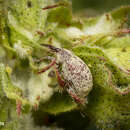pt-BR
nomes no trilho de navegação


There is a Boll Weevil Monument in the city of Enterprise, Alabama. It was built in 1919 to commemorate the economic diversification that was required after boll weevils devastated cotton crops, the only local product. (Encyclopædia Britannica Online 2001, Thom 1996)
US Federal List: no special status
CITES: no special status
Once eggs are laid the larvae hatch in about 5 days and spend the next 1 to 2 weeks feeding before developing into pupae. After pupating for about a week, adults emerge from the boll in which they developed by chewing their way out. Boll weevils can mature from egg to adult in less than 20 days, and as many as seven generations can mature in one year (Drees and Jackman 1998).
Development - Life Cycle: metamorphosis
The boll weevil can destroy entire cotton crops. When the bolls are infested with weevils, they turn yellow and fall off the plant, ruining the cotton fibers. If cotton is heavily infested, the plants may still grow, but produce few bolls, which are the parts of the plant which produce the cotton fibers which we use. (Drees and Jackman 1998)
The boll weevil is an infamous pest, that has been "the bane of cotton farmers throughout the United States" since it was accidentally introduced from Mexico in the 1800's (Milne and Milne 1980).
Until recently control of the Boll Weevil on U.S. cotton crops frequently required heavy use of chemical pesticides. This situation is changing, but in some areas, commercial cotton farming still use substantial quantities of dangerous pesticides.
The United States Department of Agriculture's Animal and Plant Health Inspection Service is sponsoring a Boll Weevil eradication program that has eliminated the species from several states (USDA APHIS 2001)
Negative Impacts: crop pest
The boll weevil lives and feeds only in cotton and closely related plants. They eat the seed pods (bolls) and the buds of the cotton flower (Milne and Milne 1980).
Plant Foods: seeds, grains, and nuts
Primary Diet: herbivore (Folivore )
Central America, Mexico, Cuba, and across the southern United States, throughout the regions where cotton is cultivated. It was introduced into the U.S. from Mexico in the late 1800's (Milne and Milne 1980).
Biogeographic Regions: nearctic (Introduced , Native ); neotropical (Native )
The boll weevil lives in and around areas where cotton is cultivated. In the spring, it mates and develops inside the cotton plant. It spends the winter in trash and leaf liter in the surrounding area (Drees and Jackman 1998).
Habitat Regions: temperate ; terrestrial
Terrestrial Biomes: savanna or grassland
Other Habitat Features: agricultural
Adult boll weevils are small (4-7 mm) beetles, and are covered by small, hairlike scales. The have a long beak or snout that extends about half the length of the body. Their color varies with age and sex from, but is basically brown, ranging from yellowish, reddish, grayish, to very dark brown. They have a distinctive double-toothed spur on the inside of each front leg. The larval stage is a white grub. The grub transforms into a brownish pupa that somewhat resembles an adult. (Milne and Milne 1980, Drees and Jackman 1998)
Range length: 4 to 7 mm.
Sexual Dimorphism: sexes colored or patterned differently
Other Physical Features: ectothermic ; bilateral symmetry
In the spring, adult boll weevils fly to cotton fields and feed for three to seven days. The weevils then mate, and the females bore into the flowers and bolls of the cotton plant and lay their eggs.
Breeding interval: As many as seven generations of boll weevils can occur in a year.
Breeding season: Breeding occurs during the warm months of the year.
Range age at sexual or reproductive maturity (female): 20 (low) days.
Range age at sexual or reproductive maturity (male): 20 (low) days.
Key Reproductive Features: seasonal breeding ; sexual ; fertilization (Internal ); oviparous
Once the eggs are laid in a boll there is no further parental care.
Parental Investment: no parental involvement